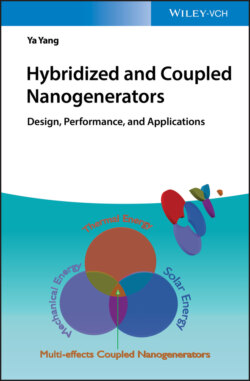Читать книгу Hybridized and Coupled Nanogenerators - Ya Yang - Страница 37
2.3.3.1 Mechanical Behavior
ОглавлениеMany flexible structures, which can be bent, folded, and twisted, were applied in the WD‐TENGs. Taneda et al. explored diversiform flapping modes, such as one‐node, imperfect‐node, and two‐node flutters. In addition, some researchers found the distinct dynamic states by using one‐dimensional filaments [73]. Wang et al. developed a TEG for harvesting wind energy based on the flow‐driven vibration of a Kapton film, and analyzed vibrating modes of the film [33]. It is found that an oscillating flow, which is known as Karman vortex shedding, was formed when wind flowed past a bluff body. Figure 2.9a shows that vortices are formed behind the bluff body and separated periodically from either side of the body. Thus, a flexible structure attached on the back of the body could periodically vibrate when wind flowed past this structure. Figure 2.9b shows the model of the designed structure, where a bluff body is fixed on the medium position of the acrylic tube and used to fix one side of the Kapton film. The tube could import air flow in a single direction, resulting in a preliminary adjustment of the flow. The air flow could be further separated by the bluff body and vibrate the free side of the film, leading to periodic contact between the film and the walls of the acrylic tube. The frequency of Karman vortex shedding can be expressed by the Strouhal number (St):
(2.3)
where V is the flow speed of the inlet port, fs is the vortex shedding frequency, and D is the height of the perpendicular edge.
Figure 2.9 Schematic illustrations and simulation of the vibration. (a) The vortex shedding effect. (b) Schematic diagram of the device. (c) The theoretical simulation of the film. (d) The fourth vibration mode in the theoretical simulation and the real deformation of the device.
Source: Reproduced with permission from Wang et al. [33]. Copyright 2015, John Wiley and Sons.
The constraint mode analysis was studied via finite element method to optimize the vibration mode of the device. Figure 2.9c shows six modes under different frequencies. The working frequency of the TEG is about 155 Hz, which coincides with the simulated fourth order mode, as shown in Figure 2.9d. Bae et al. explored dynamic characteristics of flutters in the flutter‐driven TENG, where the woven flag displayed a vibrating node [37]. The fluttering amplitude was very small above the node, but the amplitude below the node increased with increasing distance. By studying different regimes of dynamic interactions, such as single‐contact, double‐contact, and chaotic modes, the fluttering performance could be optimized to increase the performance of the TENGs. Zhang et al. used a high‐speed camera to capture the dynamic process of the contact‐separation process between two strips in the lawn‐structured TENG, and studied different modes via the finite element method [41]. The strips could be bent to contact together at the origin state under wind blow. The contact process could occur again when the atmospheric pressure exceeded the elastic restoration.
The wind flutter effect could affect the performance of the TENG. Wang et al. explored the interaction between the flow and the film by simulating the structure–fluid model [34]. This model consists of a fluid part and a solid mechanic part (solved with the Navier–Stokes equations). The results show that the bending mode was the main working condition for the film at different inlet wind speeds, as illustrated in Figure 2.10a–c. Figure 2.10d,e shows pressure and wind flow velocity distributions at a wind speed of 15 m/s. It was found that the vibrating film could work stably when the wind speed exceeded 10 m/s. On the other hand, the vibrating film worked on twist motion at low inlet wind speed (5 m/s), where the edge area of the thin film deformed more than the trailing edge. The twist motion would fade and fluttering mode form when wind speed approaches the critical wind velocity, which could be estimated by the frequency ratio of first order bending and twist mode and the respective damping ratio. Figure 2.10f shows the natural frequencies and the mode shapes of the mode shapes of first six order vibration mode, which coincides with the actual vibrations of the film observed via a high‐speed camera.
Figure 2.10 Simulation of the vibration film. (a–c) The displacement distributions of the Kapton film at different air‐flow rates. (d) Pressure distribution of the film. (e) Velocity magnitude distribution of the film. (f) Six vibration modes of the film.
Source: Reproduced with permission from Wang et al. [34]. Copyright 2015, American Chemical Society.
Surface morphology could affect the mechanical performance of the TENG. Dudem et al. explored the performance of PDMS‐based TENG with different nanopillar‐array structures [62]. It was found that increasing the period of nanopillar architectures on the surface of PDMS could enhance the uniaxial normal stresses, but the contact area was decreased. The contact force across the PDMS and electrode was enhanced in the period of nanopillars from 100 to 200 nm, and subsequently decreased. On the other hand, the contact area also could be enhanced by increasing the diameter of nanopillar architectures.
